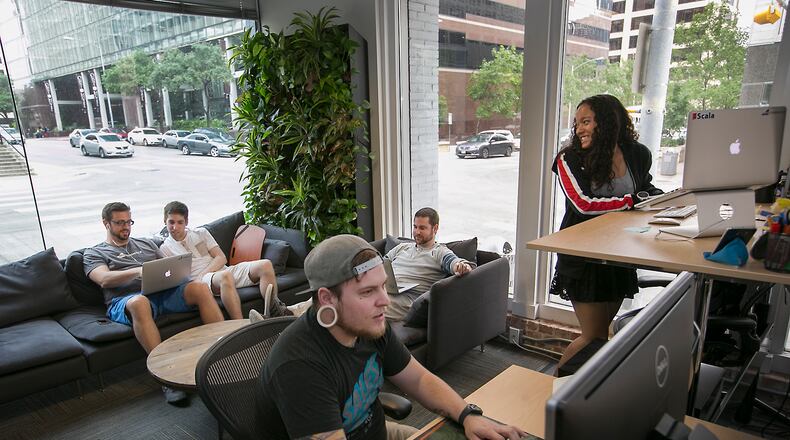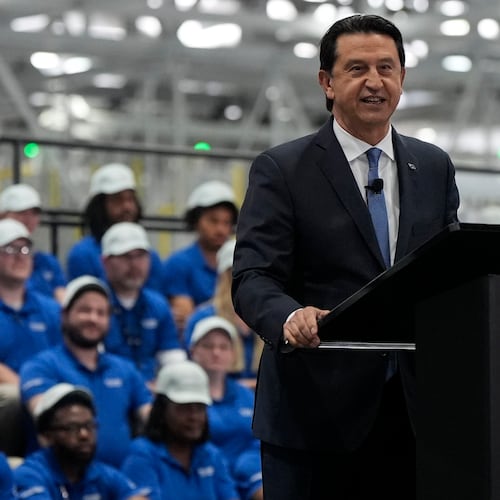Next year, Google will move into gleaming new 29-story glass office tower taking shape on the western edge of Austin’s downtown skyline.
The California-based technology giant will occupy more than 200,000 square feet of space in the building, which will feature a high-end gym and a lobby adorned with bronze paneling and reclaimed teak wood.
Google is part of a wave of tech firms that are choosing downtown offices for their Austin operations. In Austin's competitive tech sector -- there are more than 5,400 technology companies in the metro area and about 115,000 technology sector workers, according to the Greater Austin Chamber of Commerce -- companies see downtown offices as a way to attract and retain talent.
"It's simple: Developers want to be downtown, and we didn't want not being there to restrict us from recruiting them," said Robert Alvarez, chief financial officer of e-commerce software maker BigCommerce. The company opened a separate engineering center at 800 Brazos, across town from its headquarters in far Northwest Austin. "Location is one of the first things candidates ask about, and now we can show them a really hip open office space, and all the places they can walk, and they want to be there."
That location helped sell software engineer Nina Blanson on BigCommerce. Blanson, who joined the company a month ago, was accustomed to a 45-minute commute each way on Interstate 35 to her former employer. Now she lives in an apartment on the east side of downtown and walks to work.
“After spending many hours in I-35 traffic, it’s so great to not even need a car,” Blanson said. “You can just step outside for coffee or lunch or to meet friends. Everything you’d want is right outside the door.”
Credit: Laura Skelding
Credit: Laura Skelding
The arrival of tech players downtown marks a big shift from the 1990s, when the area’s most promising software firms converged in suburban offices along Loop 360 (Capital of Texas Highway), where new developments offered an abundance of affordable space.
Small tech startups began heading downtown in the early 2000s, as more high-rise condos and apartments came online, making it possible to live and work within walking distance.
Now, the latest flock is being led by big high-profile companies, from Facebook, Google, Atlassian Software and Athenahealth to Cirrus Logic, Dropbox and Under Armour, which has made downtown Austin the digital headquarters where it develops the technology for its software and connected devices, including fitness bands, heart-rate monitors, and wireless scales.
It’s a trend that further primes the downtown economy, by creating jobs, bolstering the tax base, spurring additional development, enhancing downtown’s overall vitality and fostering Austin’s reputation as a tech hub.
“Downtown is the financial engine that puts money into every other segment of the city,” said Mike Kennedy, principal and managing director in the Austin office Avison Young, a commercial real estate services firm.
The trend also is reshaping the downtown tenant base, long the realm of government offices, banks, law firms and other professional services firms. Downtown, a market with about 9 million square feet of office space, now has over 200,000 square feet of co-working space, much of which is populated by tech startups, local brokers say.
“The best and brightest want to be around the best and brightest, whether they’re working in the same company or in a different company,” said Mark Harris, an associate with Avison Young. “They like to share ideas and collaborate, and that’s one of the reasons We Work (a co-working space downtown) has done so well.”
Austin entrepreneur Campbell McNeill said WeWork’s “high energy environment, cool furniture” and location at Sixth and Congress in the heart of downtown allows his startup, Cocolevio, “to attract the young talent we need for our cloud business.”
“It would be considerably more expensive to set up a similar situation on our own as a new tech startup,” said McNeill, Cocolevio’s co-founder and chief technology officer. “We appreciate we may be paying a lot per square foot, but it is completely worth it when you consider the intangible WeWork benefits like networking with other great startups, making great friends, periodic presentations by industry leaders and WeWork Labs.”
These days, three out of four tenants looking for downtown space are likely to be tech-related, Kennedy said.
“Ten years ago, it would have been less than half that,” Kennedy said.
With its growing dining, shopping, cultural and entertainment offerings, and its proximity to outdoor amenities like Lady Bird Lake and the hike and bike trail, Austin’s central business district is a magnet for tech firms that are willing to shell out a premium in rent to woo the best talent to their teams, local office brokers say.
Gerardo Interiano, Google’s head of external affairs in Texas, said downtown was the natural place for the company to expand its Austin workforce.
“We’ve put down roots with the Google Fiber space on Second Street, and now our new downtown office space is under construction for Austin Googlers," Interiano said. "Googlers like to be outdoors, and Lady Bird Lake and Republic Square Park will be just steps away from our downtown office. We love living and working among forward-thinking Austinites who understand the value of technology.”
Credit: HANDOUT
Credit: HANDOUT
Many tech firms are willing to pay a premium for downtown space, with the costs offset in part by savings from reduced worker turnover, said Brian Butterfield of Cushman & Wakefield, a commercial real estate services firm.
Rents for the highest quality office space in downtown Austin average $49.07 a square foot per year, according to Cushman & Wakefield. That’s 40 percent higher than top-tier space in the suburbs, where rates average $35.10 a square foot per year, according to the firm.
In addition, with downtown area parking increasingly expensive and hard to find, tenants can expect to pay anywhere from $150 to $200 per month per space for unreserved parking. Reserved spots are as high as $300 per month.
The number of downtown tech workers — between 14,000 and 15,000, according to estimates from the Greater Austin Chamber of Commerce — is still tiny compared with the region’s overall technology workforce, which the chamber estimates at abou 130,000.
Dozens of software, game, mobile Web and chip design companies currently call downtown home. And, as giants like Google illustrate, more are on the way.
For Under Armour, there was never any question of locating its new digital headquarters anyplace but downtown, said Kim Davis, vice president of human resources. She said the majority of the 160 people in the Austin office live within 10 miles of downtown.
Being near Lady Bird Lake and the trail, she said, reinforces the healthy lifestyle the company promotes for its customers and employees, Davis said. The trail also comes in handy for employees as they test Under Armour’s digital fitness products prior to launch. Under Armour pays for employees’ parking, and pays incentives for those who walk or bike to work.
The company moved into its 35,000-square-foot office in March 2015, at the redeveloped Seaholm Power Plant site. Its employees include software developers, engineers and designers, and the company plans to hire 20 more people by year-end, Davis said. The office features flexible work spaces, gathering areas, outdoor terraces, in-office bicycle racks, workout facilities, game rooms and fully stocked kitchens.
In addition to a downtown location, the look of a tech firm’s space has also become a recruiting tool, Butterfield said -- the more “creative, cool and edgy,” the better.
Building owners increasingly are tailoring their buildings to respond to the desires of a new community of tech workers, many of them millennials who want interesting places and spaces to “hang out,” Kennedy said.
“You’re seeing the de-graniting and de-brassing of the 1980s buildings,” he said. In the 40-year-old downtown building where he works — 515 Congress — “virtually every floor has a tech company,” he said.
Adding tech to the downtown mix also has prompted other changes, said Adam Nims, a principal and head of Trammell Crow Company’s Austin office.
“Pet clauses are certainly becoming a more prevalent request among tech tenants, and developers are having to get creative to find ways to accommodate them,” Nims said. “Bicycle racks, car charging stations, and proximity to car sharing services like Car2Go or zip car are also becoming standard in the newest buildings.”
For software maker Atlassian, which is based in Australia, being downtown is a way to connect with the Austin community. The company's 75,000-square-foot hub on Colorado Street has the look of a modern hotel, with a sweeping staircase that serves as a gathering spot, open lounge areas and a music soundtrack playing in the background. Coffee bistros turn into beer and wine bars after hours, and two expansive outdoor terraces provide sweeping views of downtown.
There are few walls, furniture was chosen so it can be easily moved to reconfigure the space depending on what’s happening at the moment.
“We wanted to create a community space for meet-ups and we wanted to be part of the energy of downtown,” said Jeff Diana, the Atlassian’s chief people officer. “You look at the office parks outside of Austin, and there’s just not the vibrancy. For us, being in the center of where things are going on is the only place to be.”
Keep Reading
The Latest
Featured




